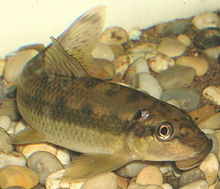Gyrinocheilus aymonieri
| Gyrinocheilus aymonieri | |
|---|---|

| |
| Gyrinocheilus aymonieri | |
| Scientific classification | |
| Domain: | Eukaryota |
| Kingdom: | Animalia |
| Phylum: | Chordata |
| Class: | Actinopterygii |
| Order: | Cypriniformes |
| Family: | Gyrinocheilidae |
| Genus: | Gyrinocheilus |
| Species: | G. aymonieri
|
| Binomial name | |
| Gyrinocheilus aymonieri (Tirant, 1883)
| |
| Synonyms | |
| |
Gyrinocheilus aymonieri is a freshwater fish native to large parts of Southeast Asia.[2][3][4] It is of interest as a local food source and for the aquarium trade.[1][3] Its common names include honey sucker, sucking loach and Chinese algae eater.[3]
G. aymonieri is found in the Chao Phraya basin, northern Malay Peninsula, Mekong basin (in Cambodia, Yunnan province in China, Laos, Thailand, and Vietnam[1]), Mae Klong basin and the Xe Bang Fai River.[2] It is most often seen in large rivers, occasionally entering flooded fields.[5] The fish spends most of its time on flat surfaces, such as rocks, in flowing water, using its unusually formed inferior mouth to attach itself to rocks in stronger flows.[6]
The fish are sold in local markets as a food source and small fish are used in preparation of prahok.[1]
Physical description
[edit]G. aymonieri has been recorded as reaching at least 28 cm (11 in) SL and is the only species in the genus to have 9 branched dorsal rays and 36–40 lateral line scales.[7] The mouth is inferior with a special "sucker" modification which allows the fish to attach itself to smooth surfaces. No barbels are present.[8]
Wild type colour varies from pale grey to olive, with darker markings along the lateral line which vary from a solid stripe with alternating higher and lower extensions to uneven dots. The belly is usually paler than the base colour. Some darker markings may also be observed along the back and on the caudal fin, but no dark markings occur on the pelvic and anal fins.[2]
Name
[edit]The scientific name commemorates the French linguist and explorer Étienne Aymonier (1844–1929).[9]
In aquaria
[edit]
G. aymonieri is similar in colouration to a number of other species which are commonly available in the aquarium trade, such as Crossocheilus oblongus, Epalzeorhynchos kalopterus, and Garra cambodgiensis,[8] and is sometimes misidentified as one of these species. It is available in a number of colour morphs, including wild type, gold, marble, albino, and leucistic forms.
The species does not breed readily in home aquaria, although fry are occasionally reported as being found in overgrown aquaria.[10] At this time, no definitive spawning triggers are known. Sexing is difficult, although mature males may develop breeding tubercles on their noses, while females become plumper.[11]
G. aymonieri fish are often bought as algae eaters because they will readily eat algae.[12]
If deprived of proper forage, they may feed off of the body slime on other fish, making them more prone to infection and stress.[citation needed]
The other species in the genus, Gyrinocheilus pennocki and Gyrinocheilus pustulosus, are rarely seen in the aquarium trade.
References
[edit]- ^ a b c d Vidthayanon, C. (2012). "Gyrinocheilus aymonieri". IUCN Red List of Threatened Species. 2012: e.T180997A1686747. doi:10.2305/IUCN.UK.2012-1.RLTS.T180997A1686747.en. Retrieved 13 November 2021.
- ^ a b c Kottelat, Maurice (July 1998). "Fishes of the Nam Theun and Xe Bangfai basins, Laos, with diagnoses of 22 new species (Teleostei: Cyprinidae, Balitoridae, Cobitidae, Coiidae and Odontobutidae)". Ichthyological Exploration of Freshwaters. 9 (1): 1–128.
- ^ a b c Froese, Rainer; Pauly, Daniel (eds.). "Gyrinocheilus aymonieri". FishBase. August 2015 version.
- ^ Eschmeyer, William N.; Fricke, Ron & van der Laan, Richard (eds.). "Species related to Gyrinocheilus aymonieri". Catalog of Fishes. California Academy of Sciences. Retrieved 13 November 2015.
- ^ Taki, Y. (1978). "An analytical study of the fish fauna of the Mekong basin as a biological production system in nature". Research Institute of Evolutionary Biology Special Publications. 1: 77.
- ^ Rainboth, Walter J. (1996). Fishes of the Cambodian Mekong. Rome: FAO (Food and agriculture organization of the United Nations). p. 265. ISBN 92-5-103743-4. Archived from the original on 2018-08-31. Retrieved 2011-10-24.
- ^ Quoting Kottelat (1998): "Distinguished from the other species of the genus in having 9 branched dorsal rays, 36–40 lateral line scales and no dark spots on pelvic and anal fins. Size up to at least 280 mm SL"
- ^ a b Frank, Neil; Liisa Sarakontu. "Algae Eating Cyprinids from Thailand and Neighboring Areas". The Aquatic Gardener: Journal of the Aquatic Gardeners Association. Aquatic Gardeners Association. Archived from the original on 2011-10-10.
- ^ Scharpf, Christopher; Lazara, Kenneth J. (28 December 2023). "Family GYRINOCHEILIDAE Gill 1905 (Algae Eaters)". The ETYFish Project. Retrieved 29 January 2023.
- ^ "Spawning Chinese Algae Eater (Gyrinocheilus aymonieri)". Retrieved 24 October 2011.
- ^ "How to keep Chinese algae eaters, Gyrinocheilus aymonieri, with pictures". Aqualand Pets Plus. 2006. Retrieved 2010-11-09.
Sexing: Males develop breeding "horns" on their heads. Females get heftier.
- ^ Apitanakul, P. and Wetchakul, W., 2002. Some biological aspects of siamese algae eater, Gyrinocheilus aymonieri (Tirant, 1884) in the Yom river, Sukhothai province. Warasan Kan Pramong.
- Sunder Lal Hora, 1935. "A Note on the Systematic Position of Psilorhynchus aymonieri Tirant from Cambodia".
- Records from the Indian Museum ,Vol. XXXVII, P. 459-461.

